1973: BNP Paribas and the Roland-Garros French Open – 50 years of a long partnership
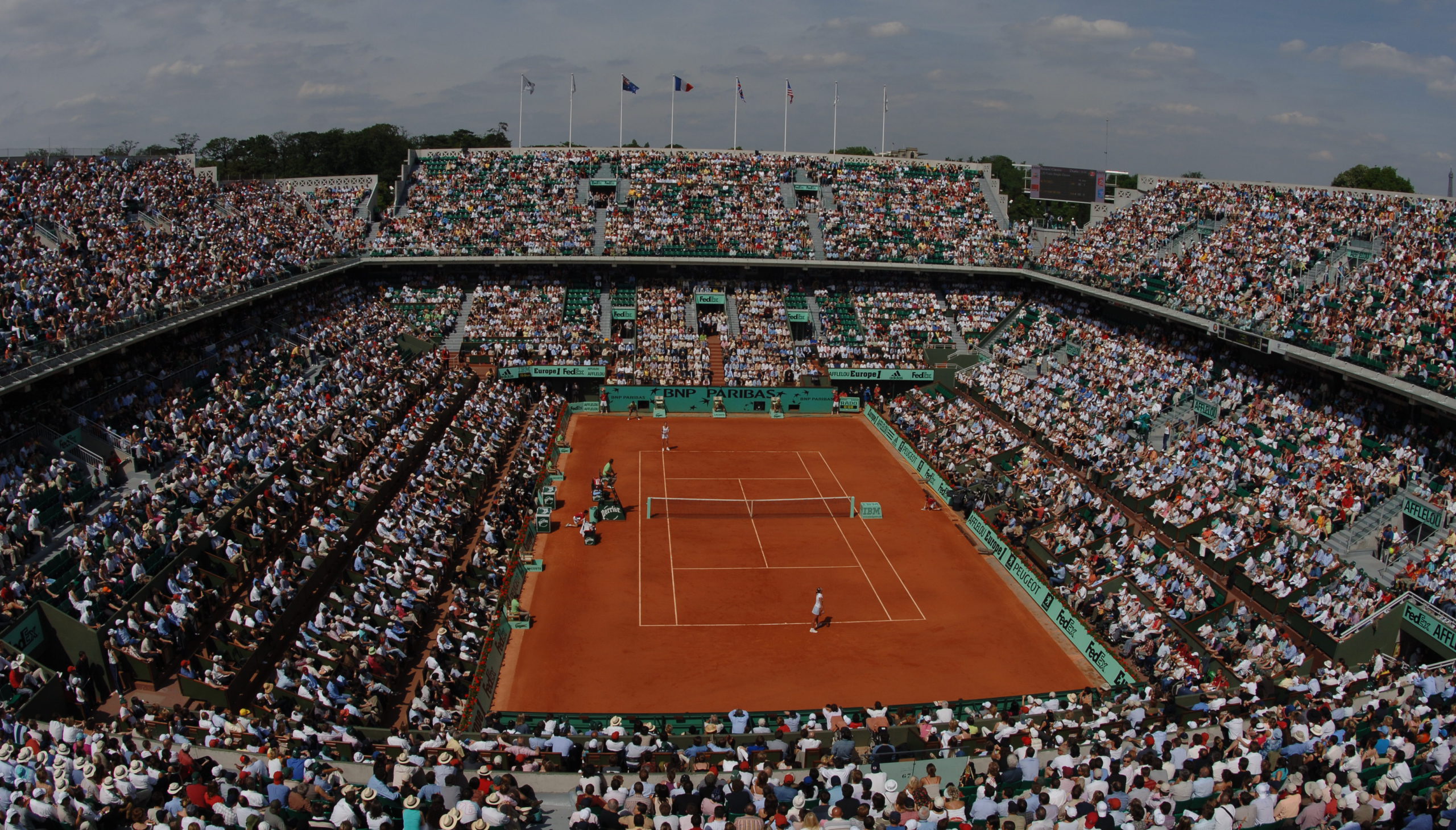
Who would have bet that Pierre Ledoux’s idea in 1973 to sign a “small” sponsorship deal with the Roland-Garros French Open to advertise the young Banque Nationale de Paris (BNP) would become the longest partnership in the history of sports sponsorship, continuously renewed for 50 years? And make BNP Paribas the official sponsor of one of the world’s greatest tennis tournaments and the number one sponsor of world tennis?
Over the years, the group has participated in the expansion of the Roland-Garros French Open and of tennis, including the expansion of the Roland-Garros stadium in 1980, the construction of court number 1 and the creation of the winter tournament in Bercy. Over the years, the French Open international tournament has helped the BNP Paribas Group’s reputation to continue to grow, both nationally and internationally. The logo on the banners around the court, of BNP and then BNP Paribas, has been around the world. The bank then became a partner to major world events, including Monte Carlo, Rome, Shanghai, the Davis Cup and the Fed Cup, to name but a few. It then supported socially-responsible initiatives by associations including “Fête le Mur” created by Yannick Noah, the “Téléthon du Tennis”, the “Oberer Tennis Camp” in Switzerland and the “BNP Paribas Taste of Tennis” in the United States.
Today, the partnership with the Roland-Garros French Open is known for 50 years of loyalty and 50 years of commitment to promoting tennis for everyone, in all its forms. Although the French Open is now one of the most closely followed sporting events in the world, and BNP Paribas is its most loyal sponsor and partner, this was not always the case.
Taking the time to build the image of a successful and fair partnership
Two partners in search of fame – a game of doubles
Birth of the Roland-Garros French Open
The Roland-Garros stadium hosted its first “Internationaux de France” tournament in June 1928. Descending from the “Championnats de France sur terre battue” created in 1891 and reserved for players registered with French clubs, the event was opened to foreign players in 1925.
In 1927, it was decided to build a stadium dedicated to defending the titles won by the “Four Musketeers” at the Davis Cup in 1927. It was named after Roland Garros (an aviation pioneer who was killed in action during the First World War) and would be built near the Porte d’Auteuil on a three-hectare site donated by the city of Paris.

BNP, a young bank that needed to make itself known
Created in 1966 by the merger of two banks – the BNCI and the CNEP – at the behest of Michel Debré, as part of national banking reforms, the Banque Nationale de Paris (BNP) grew in a context of increased take-up of banking by French households and the general public, who were under-equipped with bank accounts – at the time, only 18% of the French population had a bank account and a cheque account.
A strategy of national and international conquest was undertaken by the Group, led by Pierre Ledoux.

The French Tennis Federation (FFT) has held its bank account with the BNP branch in Auteuil since 1971. That same year, BNP set up a mobile counter in the Roland Garros grounds during the French Open, for currency exchange, player payments and emergency withdrawals for spectators. The tournament president, Philippe Chatrier, wanted to build boxes on the centre court of Roland-Garros. He needed a bank to finance the project.


In 1973, Pierre Ledoux took advantage of the withdrawal of the tournament’s former sponsor to sign a “small” partnership to finance the work.
In return, the famous banners around the court were adorned with BNP’s name. A BNP bank counter, initially mobile, also appeared.
For BNP, it was just another way of gaining publicity, by associating itself with the attractive image of tennis.
1974-1983: BNP takes the ball and runs with it in a rapidly-transforming sport
In the early 1970s, tennis quickly changed from an elitist sport to become more popular – in just a decade, the FFT increased from 167,000 members in 1970 to 800,000 in 1980. Professional players were starting to become real stars. Björn Borg came to symbolise this new tennis, being the first to benefit from the presence of cameras on court. Between 1974 and 1981, he won the French Open tournament six times. Like football players and competitive cyclists, tennis players became very popular and the number of spectators attending the tournament grew steadily.
A winning first round
Over the decade, a series of three-year contracts was signed between the two partners (1973-75, 1976-78 and 1979-1981).
On the site, BNP was only present on the banners around the courts and on the shirts of the 150 BBGs (ball boys and girls) dressed by Adidas. A BNP mobile counter was located opposite the central scoreboard. In 1978, the first live matches were broadcast on TF1, with 20 hours of transmissions. Internationally, some 20 countries broadcast the tournament, for a total of 150 hours of transmission. After 10 years of partnership, BNP’s image was linked more closely than ever with the history of the French Open (mobile counters, BBGs, guests in the BNP box). BNP became the tournament’s preferred partner.
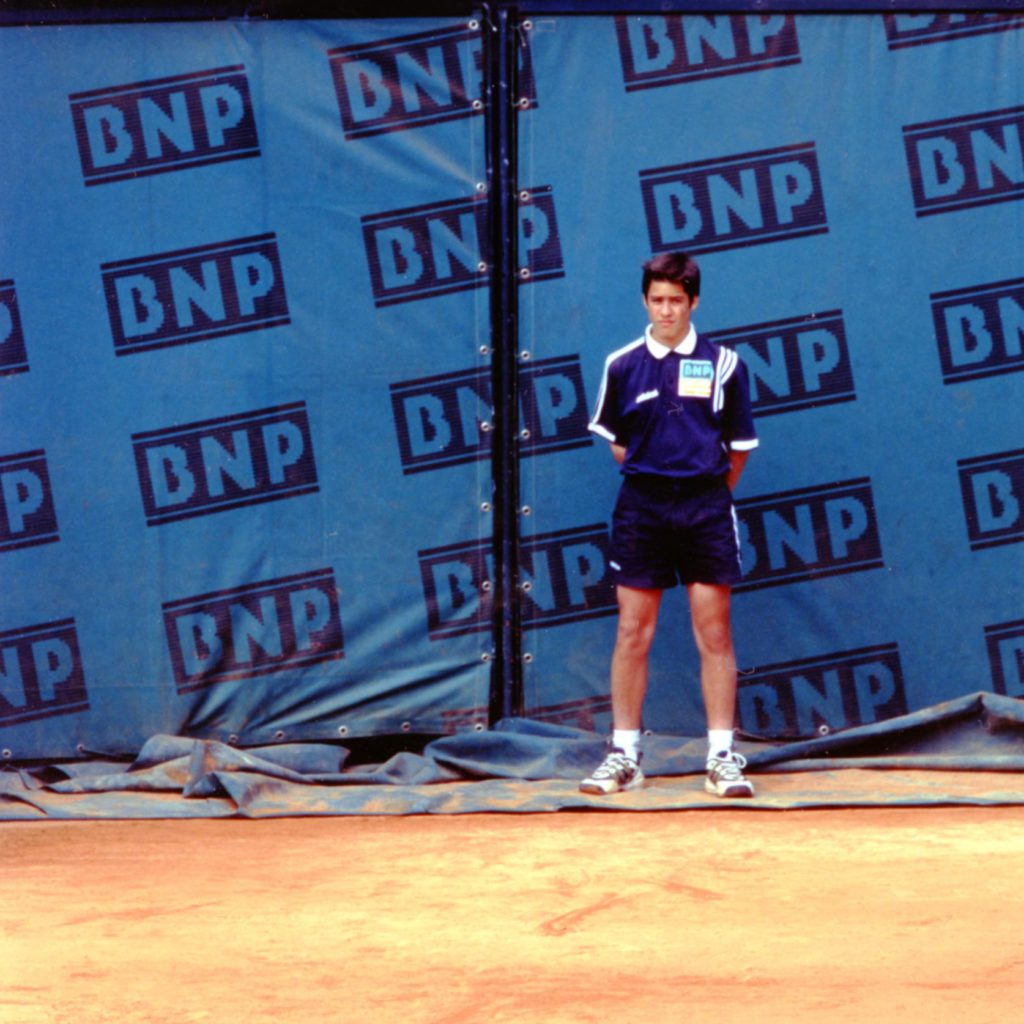
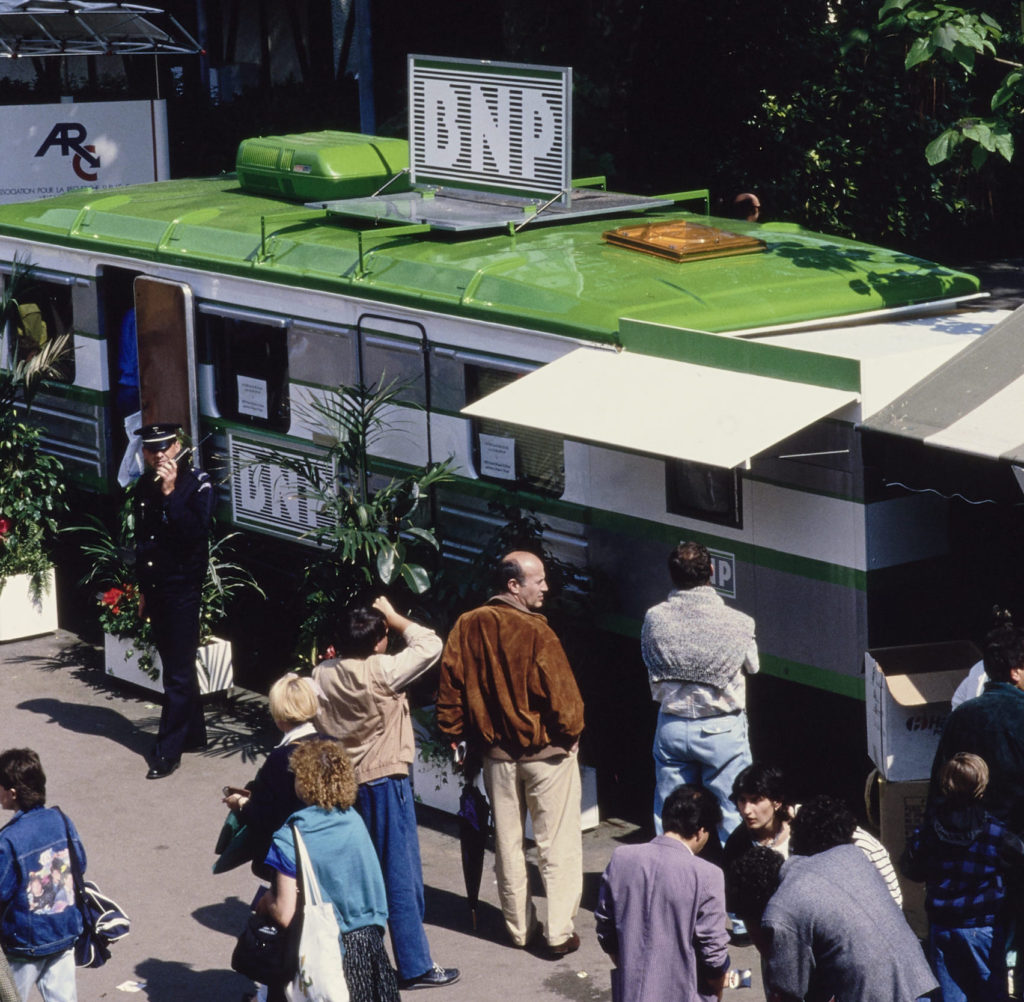
1984-1995: BNP approaches the net
Media coverage of the French Open was steadily increasing – over 300,000 spectators attended the tournament in a fortnight in 1985. TV broadcasts were more frequent and longer: in 1980-1985, TF1 broadcast 60-70 hours of the tournament, but by the turn of the 1990s that had increased to 150 hours. Abroad, the number of channels broadcasting the French Open had risen from around 30 for a total of 200 hours (in Europe, the USA and Japan) to more than 70 countries for 1000 hours. Only Wimbledon had about 20% more TV coverage in France and 50% more in Asia (mainly due to Japan).
All of a sudden, tennis came home to roost (…), and it was a huge success! I think it was a decisive factor, even economic.
JP Picquot
Head of works at the FFT in the 1970-2000’s
BNP became aware of the growing impact of the phenomenon and the need to build on its advantage. It decided to increase its sponsorship activities and was made the bank of the tournament and of the FFT, allowing the FFT to support the overall prize money awarded to the players and to keep up with the other three Grand Slam tennis tournaments.
DID YOU KNOW ?
BNP was awarded a monopoly on the title of “Official Tournament Sponsor”, the other brands being advertisers or partners, and was promoted to the position of the FFT’s principal banker. Loans granted enabled the FFT to modernise the infrastructure of the Roland Garros stadium (more courts, construction of the village, new centre court). These works provide the bank with an area to host for public relations campaigns, with 1000 invitations for the entire tournament, and the bank’s counter was transferred to permanent premises (Gallery B).
The French Open – BNP’s number one means of increasing brand awareness
BNP gradually extended its media coverage: from 1983 onwards, the bank’s advertising presence accounted for 60% of the annual budget for the French Open contract. Television, national and international media and airlines (Air France, UTA, KLM and British Airways, with sponsorship of daily summaries of the tournament in the same film), Roissy and Orly airports and the CNIT hall (sponsorship of match broadcasts) were all involved. An international press campaign was launched, with increasing visibility of the visuals and signature “BNP the French Open, official sponsor 1991”, backed by a national radio campaign with 325 ad spots to promote the campaign over the course of the tournament.



In 1987, BNP launched a new visual identity at the tournament, presenting a new logo on all the court banners and obtained an exclusive presence.
Exclusive presence on both sides of the BBGs’ shirts, whose equipment was supplied by Adidas, the FFT’s supplier since 1974.
At the same time, the bank completed its participation with a series of humorous TV commercials and press ads: “BNP the bank of the French Open”, “BNP counters open at the French Open”. Posters were put up in BNP branches echoing the themes of the press advertisements.
In fact, half of all photos taken at the Roland-Garros French Open featured BNP.
A logo was created for the 20th anniversary of the partnership in 1993. This was used on the ball boys’ uniforms, invitation cards, promotional items, sales events and in BNP branches. Lastly, BNP was given a free four-colour back cover advertisement in the official Roland-Garros French Open magazine published before each annual tournament.
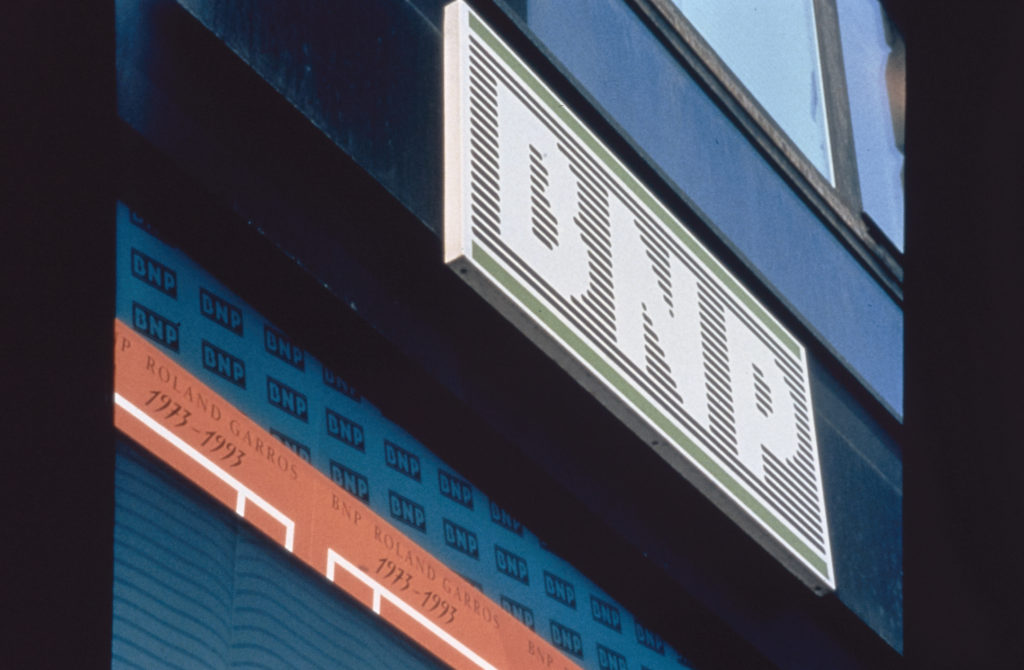

DID YOU KNOW ?
In parallel with a national expansion strategy, BNP asserted itself as a bank with a global dimension. During the 1970s and 1980s, it strengthened its position in Asia and in the Americas – in Canada and on the West Coast of the United States with the acquisition of Bank of the West, and in Latin America.
This all-out strategy paid off: awareness of the banking group rose from 87% in 1987 to 93% in 1990. This tidal wave of advertising added a dynamic touch to the bank’s image, both nationally and internationally.
Optimise your brand awareness and boost your presence to become a number one seed
After 15 years of partnership, BNP’s spontaneous awareness had slowed however. It faced competition from other tournament sponsors, who were having as much or more impact on the public, with less long-term partnerships. In 1987, the bank therefore decided to boost its visibility and broaden its targets. It therefore began full-scale targeting of the general public interested in tennis, young people and the personalities present on the site.
Public relations campaigns
From 1984, the bank carried out public relations operations over the final four days of the tournament, with 50 to 70 people invited each day to a reception tent set up on a side court. It went on to boost its public relations strategy with a 48-seat box on centre court and an approximately 75m2 private space in the “hamlet” for receptions.

A 100% winning partnership

The partnership was supported by all BNP Paribas countries, activities and business lines. It became a fantastic means of winning customers and an awareness accelerator, offering worldwide visibility, while conveying values aligned with the bank. That is why, when BNP and Paribas merged, the new BNP Paribas logo was revealed on the French Open tournament banners.
For me, the year 2000 and the launch of the new BNP Paribas brand means making the Roland-Garros French Open part of our history
Antoine Sire
Director of Engagement, BNP Paribas Group
The impact of the French Open around the world has been a major factor in raising awareness of the new brand. Indeed, tennis carries strong legitimacy, being a sport played in all countries around the world, with the same rules and the same competitors. At the same time, since 1986 BNP has been associated with the Paris Open, an annual indoor tournament held at the end of October/start of November in Bercy.
A “committed partnership” in tennis
Once its partnership with the French Open became well established, BNP – and later its successor BNP Paribas – wanted to instil new legitimacy in this partnership. A holistic approach to tennis was taken: on the one hand, modern sport cannot flourish without sponsorship and, on the other, the bank sought to give a human dimension and go beyond the cold image that people have of the banking world. This dual paradigm partly explains the impact of the partnership on the Group’s reputation and the duration of the partnership itself.

The commitment would be both corporate and commercial: by taking regular initiatives to reactivate the partnership, the bank conveyed its values of loyalty and exemplarity.
The bank and BBGs
Since 1974, the bank has invested in the recruitment, training and work of BBGs. This represents an investment in youth which, in the colours of the tournament’s official sponsor, acts as the bank’s living standard-bearer.

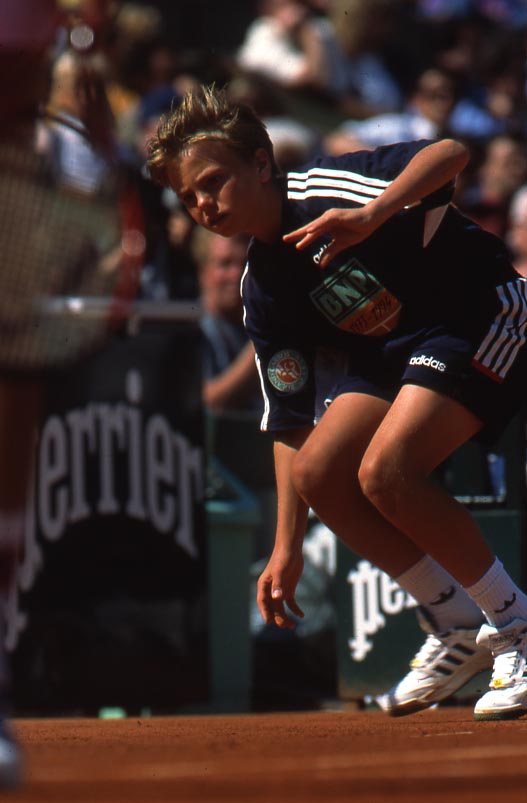

Support for grassroots players
Alongside the French Open, in the 1990s, more than 120 tournaments were sponsored by the bank throughout the region and in local tennis clubs. The best known – the Trophée Cadet de La Baule (world championship in this category), the Challenge Pro Kennex-BNP for under-14s and under-16s, the Tennis Club des Loges tournament in Saint-Germain, the Internationaux de Tennis de Toulouse, the Boulogne International Championship and the Aix-en-Provence Open. The Group intends to participate in French tennis as a whole by promoting the grassroots sport and especially youth sport.

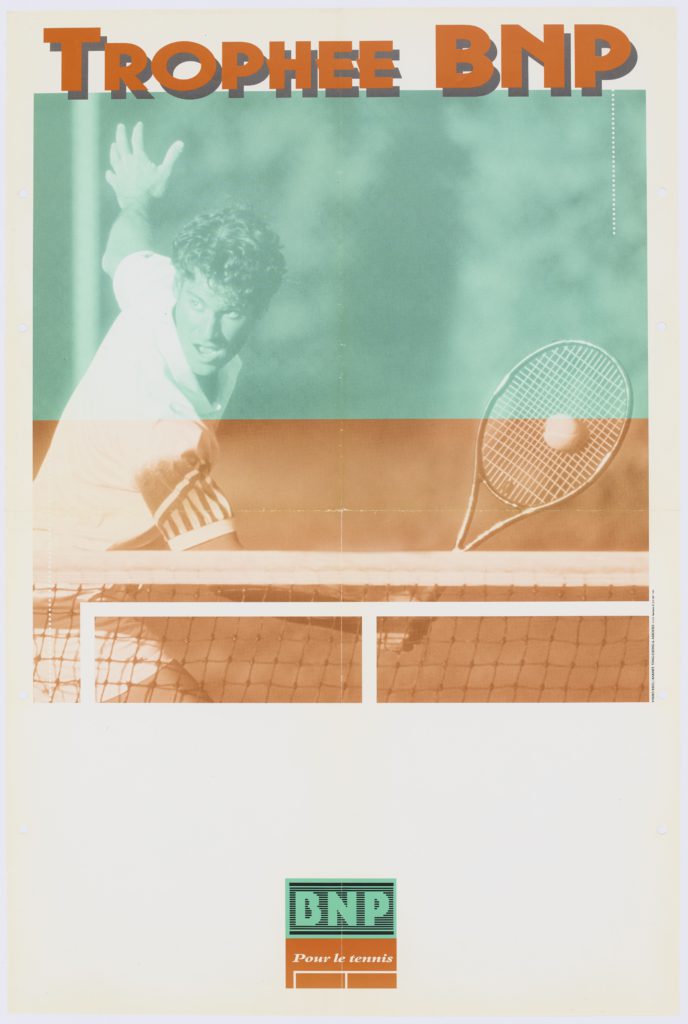
This close relationship with local clubs and tournaments is supported by promotional activities in French branches. Since 1989, BNP has been offering preferential-rate loans to FFT members and tennis clubs.

Give visibility to the partnership by targeting its customers
The French Open attracts a large and varied audience: women, young people, those in employment.
From 1991, BNP therefore began to exploit its partnership by disseminating the tennis culture throughout its network via a competition – “BNP OPEN Days”. This commercial campaign was optimised and stepped up with the general public by communicating about the bank’s savings products. This drive traffic to branches by encouraging participation in a competition to generate additional savings deposits. The results of the campaign were very positive: 304 million francs in inflows and 9,500 savings accounts opened in that first year.
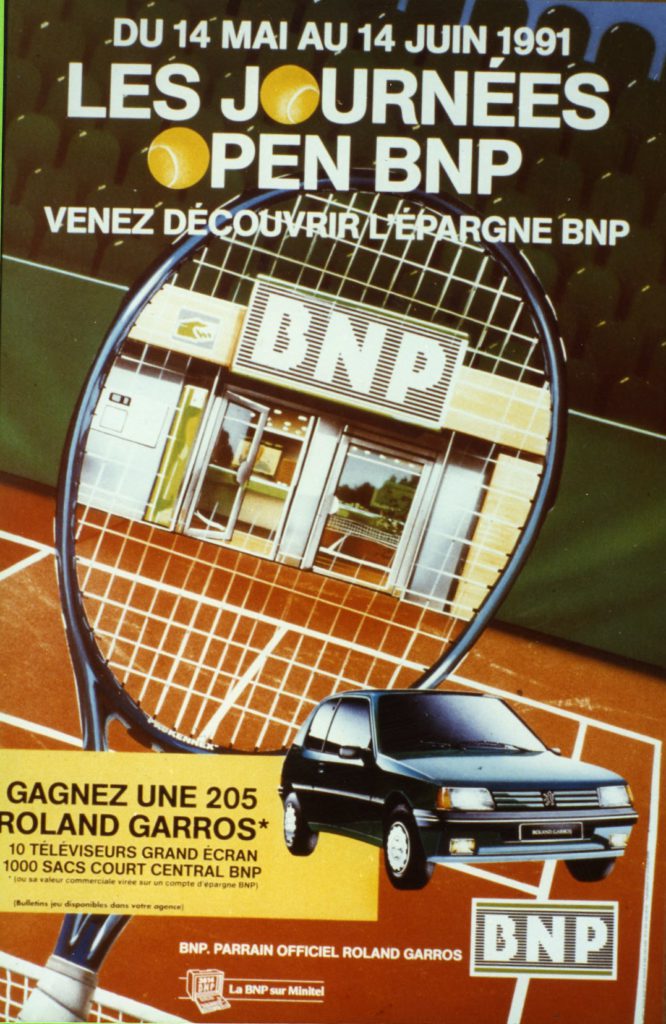
At the same time, the Group strengthened its ties with the personalities invited by BNP to the tournament through its public relations campaigns. In 2022, almost 50,000 invitations were distributed, making this the leading hospitality event for the BNP Paribas Group.
“Main Partner of the French Open” and “Partner of All Tennis Players”, on all courts
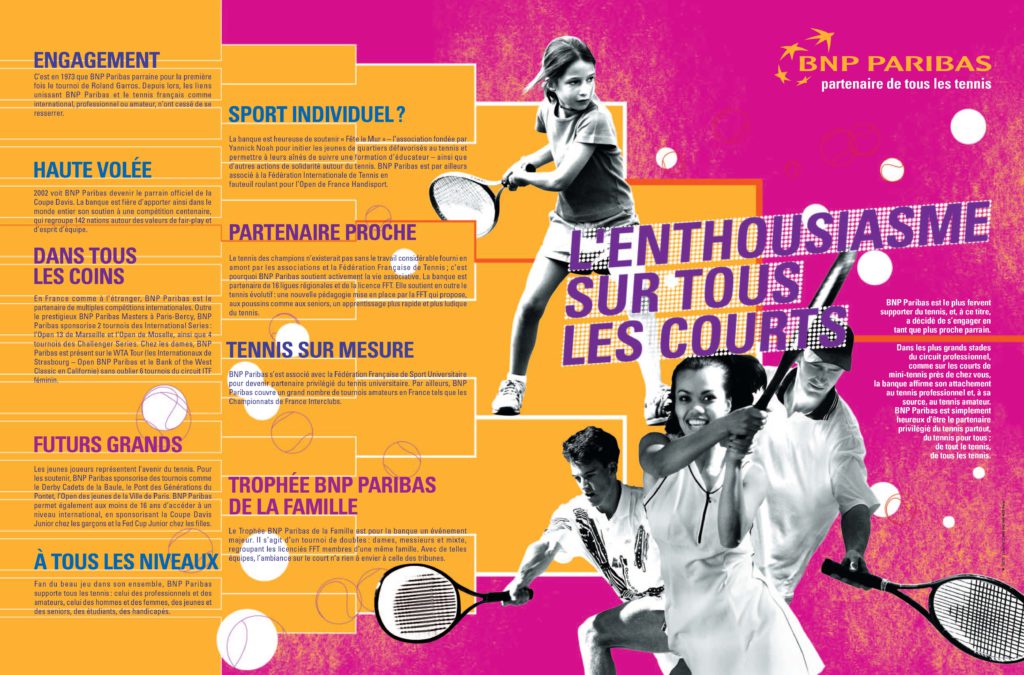
BNP Paribas supports the FFT in all major events and provides it with effective management tools to boost the federation’s development, including support for young people, small clubs, professional players, and broadcasting rights for the French Open abroad. This makes the bank the world’s leading partner in tennis.

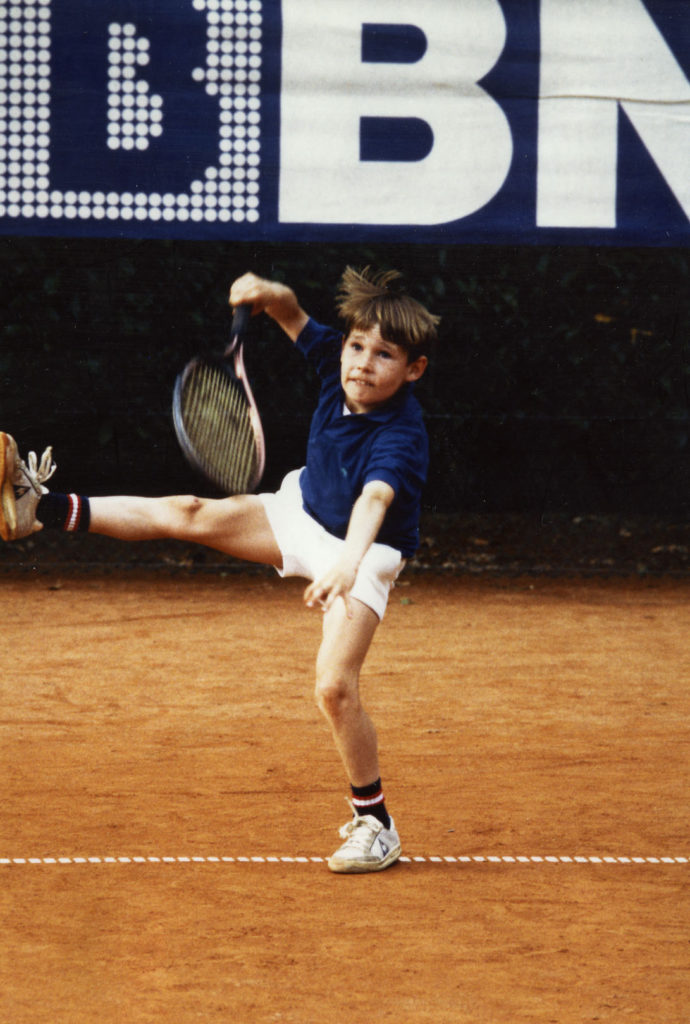

DID YOU KNOW ?
The bank currently sponsors 10 partnerships of international professional tournaments: 1 Grand Slam (French Open), 3 Masters 1000s (BNP Paribas Open, Rolex Monte-Carlo Masters, Internazionale BNL d’Italia), 1 ATP 500 (Queen’s), 3 ATP 250s (Open 13 Provence, Open Parc in Lyon, Moselle Open), 2 WTA 250s (BNP Paribas Poland Open and TEB Istambul Open)



The BNP Paribas Group has gone from being a sponsor of the French Open to the world’s leading tennis sponsor and has succeeded in extending its partnership across various courts. It is present at all levels of tennis – from beginners to top professional tournaments and in all its forms – singles, doubles, wheelchair, team and family. It is also present across all platforms, as it has been on the web since 2011 at “wearetennis.com”, a site for all fans of the sport, having previously released a virtual tournament for PlayStation, with a French Open game on CD Rom in the early 2000s.
Promoting tennis as a sport
Increasing access to tennis as a sport involves sponsoring new tennis teaching methods in order to attract new players.
This is called evolving tennis, with the development of mini-tennis, junior clubs and adult programmes.
The objective is therefore proximity whatever the level or age, at a regional or national level, in para-sport competition with wheelchair tennis.
We could mention the junior competitions (Junior Davis Cup by BNP Paribas and Junior Billie Jean King Cup by BNP Paribas) and the Open France Handisport, which the group has supported since 1993.
Today, the bank supports about 10 wheelchair tennis tournaments, as well as talented young para-sportspeople.



Getting involved in youth projects

Since 1996, based on a project devised by Yannick Noah, president of the “Fête le Mur” association, and supported by the Ministry of Youth and Sports, the FFT, local authorities and local projects, BNP Paribas has sponsored the “Seizing the ball or integration through sport” programme, which aims to give young people from disadvantaged areas access to tennis and to use the sport as a focal point and a new social dynamic.
This programme also aims to identify young talents, train them and give them access to FFT clubs, as well as opening up positions for “big brothers” from these priority neighbourhoods to coach the youngest players.



DID YOU KNOW ?
For the Group, which has a strong presence in corporate communication in high-level tennis, involvement in this programme is intended to be a natural extension of its action in the world of tennis, enabling it to expand its activities, while retaining its status as the number one media partner and becoming an active sponsor of tennis. Through its bank branches, the bank works with public authorities and sponsors international programmes dedicated to the younger generation and inclusion, such as Team Jeunes Talents in France (with Yannick Noah and Jo-Wilfried Tsonga), the USA (with John and Patrick McEnroe), Belgium (with Justine Hénin), and in the wheelchair tennis programme in Japan. More recently, a bespoke programme was set up for Félix Auger-Aliassime, who is working to protect and support the education of children in Togo. For each point scored, Félix donates $5 and BNP Paribas donates $15 to the project operated by the NGO Care in Togo.
Finally, BNP Paribas has not forgotten the hospitable and environmental dimension of tennis, with nearly 30 Aces du Cœur operations supported since 2006.
Game set and match
The partnership has enabled both the French Open and BNP, and then BNP Paribas, to assert themselves in their respective categories. These two small players 50 years ago have become big, having established a real win-win partnership, which has seen the reputation of the clay-court tennis tournament explode, to become the most followed in the world today, while the BNP Paribas Group, its historical partner, has become the number one sponsor of tennis, regardless of the court.
The Group, meanwhile, was able to identify the advantages of this sponsorship relatively early on, by integrating it into the Group’s overall development strategy. Through its simultaneous support for the FFT, the bank has been able to “get out of the Roland-Garros French Open” and is committed to the development of tennis as a mass sport, wherever it may be. This has given BNP Paribas legitimacy as an undisputed sponsor of tennis, based on the common values that unite the two partners: fair play, performance and ethics.
Over the years, tennis has become a commitment tool for the Group. Today marks 50 years of loyalty to tennis. Being together, throughout the Group. BNP Paribas is the bank for all tennis players, especially in the regions. The 50th anniversary is a time to make history by looking to the future.
Antoine Sire
on the 50th Years of Tennis celebrations00’s




